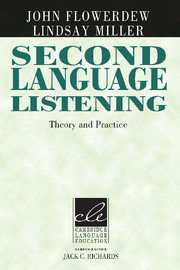Book contents
- Frontmatter
- Contents
- Series editor's preface
- Preface
- Acknowledgments
- Part I HISTORICAL BACKGROUND
- Part II A PEDAGOGICAL MODEL AND ITS APPLICATION
- Part III KEY ISSUES IN TEACHING AND TESTING
- 9 Developing Listening Skills through Technology
- 10 The Role of Questions in the Teaching of Listening
- 11 Testing Listening
- Appendix: Concluding Questions for Reflection
- References
- Index
11 - Testing Listening
Published online by Cambridge University Press: 04 February 2010
- Frontmatter
- Contents
- Series editor's preface
- Preface
- Acknowledgments
- Part I HISTORICAL BACKGROUND
- Part II A PEDAGOGICAL MODEL AND ITS APPLICATION
- Part III KEY ISSUES IN TEACHING AND TESTING
- 9 Developing Listening Skills through Technology
- 10 The Role of Questions in the Teaching of Listening
- 11 Testing Listening
- Appendix: Concluding Questions for Reflection
- References
- Index
Summary
Introduction
In this last chapter, we present some of the main ways in which listening can be tested. Many of the types of questions associated with testing also appear in the teaching of listening (see Chapter 10). However, there are significant differences, or at least there should be, in how we ask questions to elicit comprehension and how similar types of questions are asked to test comprehension. This chapter on testing listening is necessarily brief; more complete discussions can be found in Brindley (1998), Buck (2001), Heaton (1990), Oller (1979), and Thomson (1995).
Buck (2001) tells us that there have been three historical developments in testing listening. These developments correspond to the theories of language learning and the different methods used to teach English over the past 60 years or so (see Chapter 1). These are the three approaches (see Table 11.1):
the discrete-point approach
the integrative approach
the communicative approach
The discrete-point approach is derived from structuralism and behaviorism. The focus here is on the identification of isolated items of the language. That is, separate parts of the language are tested independently of each other; for instance, segmental phonemes, grammatical structures, and lexis are all treated as separate entities. The types of tests that can be used with the discrete-point approach are phonemic discrimination (identifying differences between phonemes), paraphrase recognition (reformulating what was heard), and response evaluation (responding appropriately to what was heard). The assumptions behind this type of approach to testing listening are that spoken text is the same as written text and that individual parts of the language can be isolated and tested.
- Type
- Chapter
- Information
- Second Language ListeningTheory and Practice, pp. 198 - 210Publisher: Cambridge University PressPrint publication year: 2005



